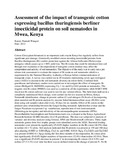| dc.description.abstract | Cotton (Gossypium hirsutum) is an important cash crop in Kenya but regularly suffers from significant pest damage. Genetically modified cotton encoding insecticidal proteins from Bacillus thuringiensis (Bt) confers protection against the African bollworm (He/icoverpa armigera) which causes up to 1 00% yield loss. The Bt toxins that could be introduced into soil through root exudation or decomposition of transgenic cotton residues may affect the composition and activity of soil nematodes. The objective of the study was to carry out a pre release risk assessment to evaluate the impact of Bt toxin on soil nematodes which is a requirement by the National Biosafety Authority of Kenya before commercialization of transgenic crops. A survey was carried out in 20 locations representing seven agro ecological zones (AEZs) to document the soil nematode diversity in cotton fields.
Confined field. greenhouse and laboratory studies were carried out to investigate the effect of transgenic Bt cotton (BolJgard Il, 06Z604D) expressing Cry 1 Ac and Cry2Ab2 protein on nematodes. The isogenic non Bt cotton (99M03) was used as a control in all the experiments while HART 89M (local non Bt cotton cultivar) was used to test for any varietal effects. The field trials laid out in a completely randomized block design, were carried out for two seasons at Mwea, Kenya. Nematode identification, change in percent carbon (C) and nitrogen (N) levels of decomposing plant material and Bt protein analysis by enzyme linked immunosorbent assay (ELISA) were done using soil samples taken after every 30 days for six months.
Effect of Bt cotton on the predator-prey relationship between the fungal feeding nematode Aphelenchus avenae and the fungus Fusarium oxysporum f sp. vasinfectum, reproduction of root knot nematode (Meloidogyne incognita) and infectivity of the entomopathogenic nematodes (EPNs) Heserorhabditis bacteriophora and Steinernema karii was evaluated at the Kenya Agricultural Research Institute (KARl) biosafety level II greenhouse. The data was subjected to analysis of variance and diversity analyses using Genstat, SPSS and BiodiversityR softwares. Thirty eight nematode genera from five trophic groups were identified across the AEZs. Bacterial feeding nematodes were present in significantly (P<0.05) higher numbers in the Bt cotton (46.9%) than in isoline (42.1 %) plots. Soil analysis indicated that Bt protein was present at 150 and 180 days after planting (0.0001 to 0.0014Jlg/g, Cry] Ac and 0.006- 0.0141 Jlg/g, Cry2Ab2) and Cry2Ab2 was present (0.0092-0.1 Jlg/g) during the first three months of decomposition. Bt cotton plots had significantly (P<0.05) higher numbers of bacteriovores (52.8%) than isoline (43.9%).
There was a significant (P<0.05) decrease in percent C in decomposing Bt cotton (24.4-5.9%) and isoline (27.5-5.3%) over time but there was no defined trend in the change of percent N. No Bt protein was detected in the isoline and HART 89M treatments. Bt cotton did not have any effect on infectivity of EPNs and on the trophic interactions between nematodes and fungi. This study has also shown that Bt cotton stimulates reproduction of M. incognita and causes an increase in the numbers of bacterial feeding nematodes. Additional studies are therefore necessary in order to understand the long term effects ofBt cotton on nematode diversity and their relationship with other soil organisms. | en_US |

